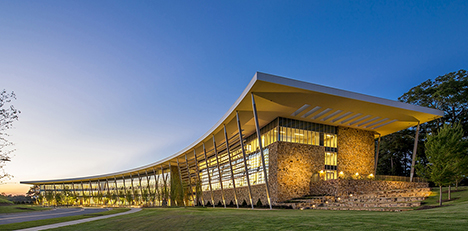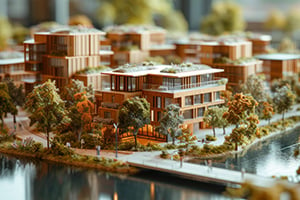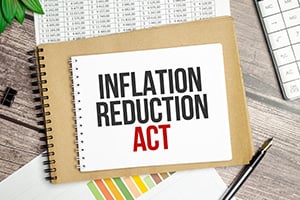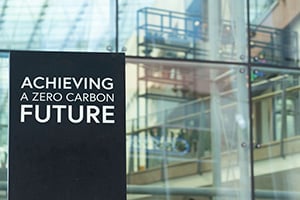By Anne Nichols
Sustainablility Analyst Intern, Sustainable Investment Group (SIG)

Through metal gates and atop a sprawling green hill sits the new Charles R. Drew Charter School Senior and Junior Academy, the most recent campus addition to a cradle-to-college pipeline in East Lake, Georgia. Five minutes after the beginning of classes no tardy or loitering students are in sight. Through the ceiling-to-floor windows, students dressed in forest green blazers sit in rows paying close attention to their band director’s baton. It is clear from the pristine façade of the building that the students and teachers take pride in their school. How much of that pride might come from the beautifully designed and newly constructed building?

The Junior and Senior Academy began construction in 2013 and was completed in July 2014 as a capstone project for the East Lake Foundation’s cradle-to-college pipeline. The school, founded in 2000, serves children in the East Lake community all the way from early education to higher education. During the design phase of the new academy, the administration decided to pursue Leadership in Energy and Environmental Design (LEED) certification.
Laura Bollman, the Director of Program Design and Implementation for Drew Charter School, says she “truly believes that our school is an environment that we want our students to learn in and learn from, so along the way we decided to pursue LEED as we saw the overlaps continuing to happen between what we wanted to do green building wise and what LEED was offering.”
Across the nation, there are currently 866 LEED certified schools and 1,269 schools in the process of becoming certified. In Georgia, 22 schools are certified and 16 are in the process, Drew Charter School being one of those. The Junior and Senior Academy is currently pursuing a gold level certification, the second highest possible.
LEED is a rating system with a set number of points earned by incorporating green building practices and sustainable systems into design, construction, and operations and maintenance of building. The number of points achieved determines the building’s certification level from “certified” being the lowest to “platinum” being the highest. Categories include sustainable sites, transportation and location, energy and atmosphere, water efficiency, materials and resources, indoor environmental quality, and innovation.
Leesa Carter-Jones, former executive director of the U.S. Green Building Council (USGBC) – Georgia Chapter, believes schools should pursue LEED for student health and economic reasons.
Charlie Cichetti, chief executive of Sustainable Investment Group, a LEED consulting firm, says “I think those that would be opposed to LEED certified schools are more opposed to idea that it’s going to cost a lot more for this school that we can barely afford in the public environment.” The increased cost he is referring to is the “green premium,” which is higher upfront costs when designing with sustainability in mind.

Some of these higher costs are results of increased energy- or water- efficiency systems, locally-sourced or renewable resources, and low-chemical furniture, carpet, and paints. However, this only takes into account the construction budget. Mr. Cichetti believes it is important to think long term about green schools to truly understand the cost-benefit analysis. A green school may have a higher initial cost, but when viewed through the lens of the life cycle of the school, tremendous savings may be accounted during the operations.
A majority of these operational savings are through monthly utility bills. In a study performed by the U.S. Green Building Council, a green school will typically use an average of 33% less energy and 32% less water than their traditionally functioning counterparts.
Additionally, this does not account for rising utility prices. According to the U.S. Energy Information Administration, the U.S. average electricity price rose 3.2% from 2013 to 2014. The highest increase was seen in New England where they witnessed an 11.8% jump. Energy prices are not projected to decline any time soon, so designing for energy-efficiency is a smart way to plan ahead.
Green schools accomplish energy savings by installing energy-efficient heating and air conditioning systems, providing natural ventilation, or even installing their own renewable energy source, such as a solar panel or wind turbine.
According to The Center for Green Schools, schools that invest in these practices during the construction phase and incur the “green premium” are able to compete with the rising electricity prices and allocate funds previously spent on energy to more needed areas such as teacher development or educational resources. In a study by The Center for Green Schools, they claim “on average, green schools save $100,000 per year on operating costs — enough to hire at least one new teacher, buy 200 new computers, or purchase 5,000 textbooks.”
On top of the savings from green schools, LEED schools have a big influence on the students and teachers. Students spend an upwards of 943 hours in the school building a year, so a building that encourages student function and health is imperative to a healthy school.
“The schools are healthier for the students meaning that they have less volatile organic compounds indoors and they aren’t allowed to use harsh chemicals when they’re cleaning the schools,” says Carter-Jones, the former USGBC director, “so the kids who have allergen response to that or who may be asthmatic have a much lower incidence of inhaler use in schools that are green.”
The LEED rating system puts heavy emphasis on indoor environmental quality, which awards points for mold prevention, using low-emitting materials, and janitorial plans that eliminate hazardous and chemical laden cleaning supplies. These measures can help prevent symptoms in students suffering from asthma, flu, respiratory problems, and headaches.
The Berkeley National Laboratory approximated that improved air quality and ventilation indoors would reduce flu and cold-like illnesses by 9-20% throughout the general population, resulting in 16-37 million cases avoided. By applying these numbers to a student population, it can be assumed these figures are conservative considering how children are often times more susceptible to these types of illnesses.
Mr. Cichetti has previously worked with schools helping them to implement, track, and document LEED credits. One of his favorite requirements and also most challenging to provide is minimum acoustical performance. “You must have a certain decibel level for your [heating, ventilation, and air conditioning] system,” says Cichetti. “If you have a child sitting in the back of the room and they can’t hear the teacher in the front of the room, that’s just not productive.”
As exemplified in Drew Charter School’s building, large windows and classrooms on the perimeter of the building allow for natural light to shine into the building and give the students a connection to the outdoors. An increase of natural light from the outside also lessens the amount of artificial light needed in the classroom.
A study by the Heschong Mahone Group showed “that students with the most daylighting in their classrooms progressed 20% faster on math tests and 26% faster on reading tests in one year than those with the least.”
Overall, LEED certified schools seem to have numerous beneficial effects. “It’s a real sense of pride in this community,” Bollman notes, “We wanted to design this building so that when you show up here every morning you know that you’re important and that education is important, and I think that’s something our teachers, our administrators, our students, and our parents all feel on a daily basis.” By incorporating LEED into their building design she says it promotes the environmental responsibility that is shared throughout the Drew Charter School community.
Carter-Jones says when students are located in a LEED certified school and surrounded by new technologies in waste and energy reduction, high recycling and compost recovery, and green cleaning, it raises their awareness and initiates a conversation. “It begins to create a community change and transformation which I think is at the heart of what the green building industry is trying to do.”
References Cited
- Baker, Lindsay, and Harvey Bernstein. The Impact of School Buildings on Student Health and Performance. Rep. McGraw Hill Research Foundation, 27 Feb. 2012. Web. 19 Apr. 2015.
- Bollman, Laura, Interview, 13 Apr. 2015, Contact: lbollman@cffdn.org
- Carter-Jones, Leesa, Interview, 24 Mar. 2015, Contact: lcarter@captainplanetfdn.org
- Cichetti, Charlie, Interview, 10 Apr. 2015, Contact: charliec@sigearth.com
- “Green Schools Save Money.” The Center for Green Schools. The Center for Green Schools, n.d. Web. 19 Apr. 2015.
- Heschong Mahone Group. “Windows and Classrooms: A Study of Student Performance and the Indoor Environment.” Heschong Mahone Group. Hechong Mahone Group, 2003. Web. 26 Apr. 2015.
- Hodge, Tyler. “U.S. Energy Information Administration – EIA – Independent Statistics and Analysis.” Residential Electricity Prices Are Rising. U.S. Energy Information Administration, 2 Sept. 2014. Web. 19 Apr. 2015.
- Kats, Gregory. “Greening America’s Schools: Costs and Benefits.” (n.d.): n. pag. U.S. Green Building Council. Capital E, Oct. 2006. Web. 19 Apr. 2015.
- Langdon, Davis. “Cost of Green Revisited: Reexamining the Feasibility and Cost Impact of Sustainable Design in the Light of Increased Market Adoption.” (n.d.): n. pag. The Center for Green Schools. The Center for Green Schools, July 2007. Web.
Photo credits (all 3): Perkins + Will Architects
© 2015 Sustainable Investment Group (SIG). All Rights Reserved.



